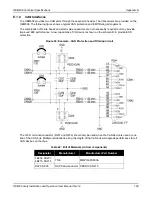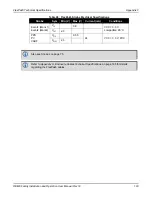
OEM638 Technical Specifications
Appendix E
OEM6 Family Installation and Operation User Manual Rev 12
185
E.1.7
USB Interfaces
The OEM638 provides three USB2.0 High Speed interfaces.
HSUSB0 is configured as a device and is capable of operating at High Speed (480Mbps). Full speed (12
Mbps) and Low Speed (1.5 Mbps).
HSUSB1 and HSUSB2 are host ports and are capable of High Speed (480 Mbps) operation only. If it is
desired to use the host ports with Full or Low Speed devices, a USB hub (with a transaction translator) is
required between the OEM638 and the USB device. These ports are designed with a 3.3 V CMOS-level
control output for an external 5 V power switch that will provide the power switching and current limit
protection.
It is imperative for signal integrity and EMI reasons that the differential data traces for each USB interface be
routed as a 90
Ω
differential pair. Use of a small value common mode choke (as shown in
- Connecting HSUSB0 to a Micro-B Type USB Connector
on page 185) may improve the radiated emissions
performance. Small ferrite beads, ESD protection are shown on VBUS and UID lines as a contingency
against radiated emissions.
The “HSUSBx_VBUS” signals are only present so that the PHY on the OEM638 may monitor activity on each
bus and are required for operation, although they will only carry a few mA maximum. The traces for VBUS
and UID should be routed away from any high current switching nets and high frequency signals. The
common mode choke, ferrite beads and bypass capacitor should be placed as close as possible to the USB
connector.
If a Type B or Type mini-B USB connector is used for HSUSB0, the “HSUSB0_UID” pin from the OEM638
should be left floating (as there is no pin on those variants of the USB connector to connect to). If a Type
micro-B connector is used, the “HSUSB0_UID” pin should be tied to the UID pin of the connector (as shown
below).
Figure 94: Example - Connecting HSUSB0 to a Micro-B Type USB Connector
















































